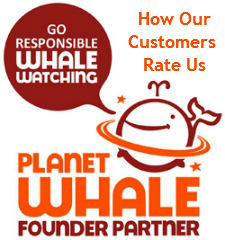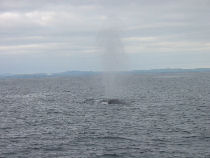Whale Watching |
|
The southern California coast during the late 1950's saw the first commercial whale watching activity. This industry has since grown to become a worldwide activity carried out in over 40 countries including Antarctica. Many large species of toothed and baleen whales are viewed along with a wide number of dolphin and porpoise species from a variety of vessels on tours lasting from hours to days. Whale and dolphin watching is a sustainable use of cetaceans that has conservation, educational, economic and research benefits. Conservation benefits for the marine habitats in general. Educational advantages for both children and adults in allowing the wider conservation message to be broadcast. Economic benefits to coastal communities and those involved in redundant industries. Scientific benefits through the use of tour boats as research platforms and the information that can be relayed back to those involved in the study of cetaceans. New tour operators entering the whale and dolphin watching industry must look carefully at those regions and countries that have mature whale watching sectors. This will ensure that whale and dolphin watching will continue to grow on a world wide basis with maximum benefits to all interested parties, not least of which, the whales and dolphins themselves. Whale Watching in EuropeWith the exception of Norway and Iceland most European nations have embraced the positive aspects of whale watching over commercial whaling. During the next few years over 2.5 million people annually are expected to take a tour to view whales and dolphins in their natural habitat in maritime Europe. Apart from the benefits of public education, improved conservation status for whales and dolphins and socio-economic benefits, the income whale and dolphin watching and peripheral sales are likely to generate per annum is in excess of 220 million Euro for coastal communities. Norway and Iceland stand alone in their attempts to run a whale watching industry alongside scientific whaling - commercial whaling by another name and a practice that has been condemned the world over as lacking any foundation in science. Most European countries that have a whale watching industry ensure their operators comply with an internationally recognized set of minimum guidelines - some individual operators still contravene these guidelines and risk stressing the animals unnecessarily. Anybody whale watching in Europe should ensure at all times that any operators they take tours with comply with a minimum set of guidelines and should be outspoken if they feel that any tour boat skipper fails to meet the spirit of these guidelines and harasses the animals in any way. Some of these guidelines are inadequate but Whale Watch West Cork is leading the way in developing a more comprehensive set of guidelines at the species level which we hope will ultimately be adopted Europe wide. Whale Watching from the LandSuch is the proliferation of whale and dolphin watching activities around the globe that they are viewed from the land, sea and air with a number of operators specializing in tours for visitors on a range of budgets. For those on a limited budget a cost effective way of watching whales or dolphins is from the land. There are a number of geographical sites around the world that enable consistent and close sighting of some of the world's largest marine mammals. Little equipment is required for effective land based whale and dolphin watching. Whale Watch West Cork have a database on a selection of the best places to view whales and dolphins around the world and are happy to answer any enquiries regarding places to go, equipment needed and times of the year to view. Please contact Nic Slocum on the email provided and he will be happy to provide you with some information that will help you plan your land-based whale-watching trip, wherever it might be. Return to TopOur Dolphin & Whale Watching Tours
|
Click on images for larger view:
|
Whale WatchingWhale Watching in IrelandWhale Watching TripsWhale Watching HolidaysDolphin WatchingDolphin EncountersDolphin HolidaysOther Marine Wildlife Tours |
More About WhalesWhale ConservationWhale PicturesMore About DolphinsDolphin PicturesPorpoisesSealsAbout
|
Inspirations
No one could make a greater mistake than he who did nothing because he could do only a littleEdmund Burke
Mohandas Gandhi














